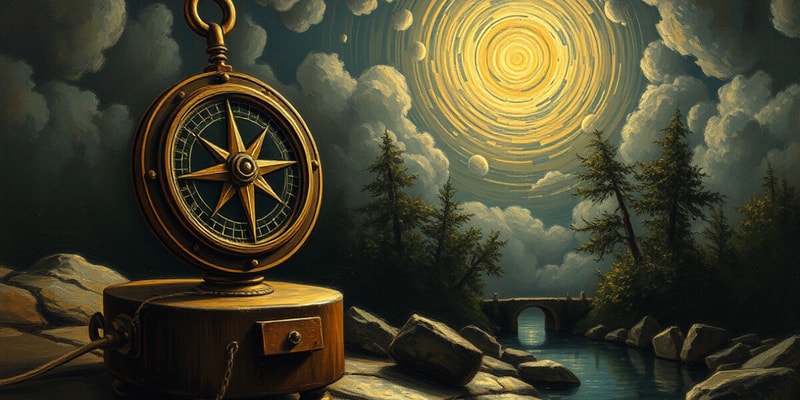Podcast
Questions and Answers
What is the primary material discovered by the Greeks in 800 BC that attracted pieces of iron?
What is the primary material discovered by the Greeks in 800 BC that attracted pieces of iron?
Who is credited with the discovery that a changing magnetic field creates an electric field?
Who is credited with the discovery that a changing magnetic field creates an electric field?
What did Pierre de Maricourt discover about the direction of a magnetic needle near a spherical natural magnet?
What did Pierre de Maricourt discover about the direction of a magnetic needle near a spherical natural magnet?
What happens when like magnetic poles are placed near each other?
What happens when like magnetic poles are placed near each other?
Signup and view all the answers
According to the behavior of magnets in Earth's magnetic field, what is true about the Earth's north geographic pole?
According to the behavior of magnets in Earth's magnetic field, what is true about the Earth's north geographic pole?
Signup and view all the answers
What type of relationship exists between electric charges and magnetic poles?
What type of relationship exists between electric charges and magnetic poles?
Signup and view all the answers
What concept did James Clerk Maxwell propose regarding electric and magnetic fields?
What concept did James Clerk Maxwell propose regarding electric and magnetic fields?
Signup and view all the answers
What is the name given to the two ends of a magnet?
What is the name given to the two ends of a magnet?
Signup and view all the answers
Study Notes
Historical Development of Magnetism
- 13th century BC: Chinese utilized a compass featuring a magnetic needle, likely deriving from Arabic or Indian innovations.
- 800 BC: Greeks identified magnetite (Fe₃O₄), establishing that it attracts iron fragments.
- 1269: Pierre de Maricourt discovered that a needle near a spherical natural magnet traced lines encircling the sphere, identifying two points he named poles.
Key Contributions to Magnetism
- 1820s: Michael Faraday and Joseph Henry advanced the understanding of the relationship between electricity and magnetism, establishing that a changing magnetic field generates an electric field.
- Maxwell’s equations further clarified that a changing electric field induces a magnetic field in return.
Understanding Magnetic Poles
- Every magnet possesses two poles, designated as north and south.
- Poles exert forces similar to electric charges:
- Like poles (N-N or S-S) repel each other.
- Unlike poles (N-S) attract each other.
Earth’s Magnetic Field
- The naming of magnetic poles is influenced by their behavior in relation to the Earth’s magnetic field.
- A freely suspended bar magnet will align such that its north pole points towards the Earth's north geographic pole, indicating that the Earth's north geographic pole functions as a magnetic south pole.
- Conversely, the Earth's south geographic pole is classified as a magnetic north pole.
Studying That Suits You
Use AI to generate personalized quizzes and flashcards to suit your learning preferences.
Description
Test your knowledge on the significant milestones in the history of magnetism, from ancient compass usage to the groundbreaking discoveries made by Faraday and Maxwell. This quiz explores key figures, inventions, and scientific principles that shaped our understanding of magnetism.




